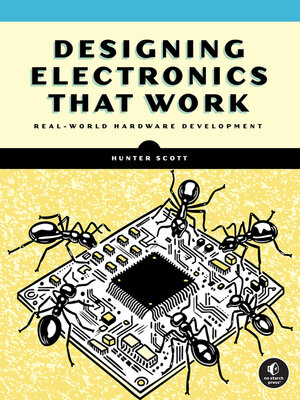
Sign up to save your library
With an OverDrive account, you can save your favorite libraries for at-a-glance information about availability. Find out more about OverDrive accounts.
Find this title in Libby, the library reading app by OverDrive.



Search for a digital library with this title
Title found at these libraries:
| Library Name | Distance |
|---|---|
| Loading... |
How real engineers build electronics—one working piece at a time.
If you’ve ever had a board fail on power-up, spent hours debugging a layout that “should work,” or run into a supplier problem just before a deadline—you already know this isn’t just about theory. It’s about judgment, decisions, and real-world constraints.
Designing Electronics That Work is a guide to all the practical things you won’t find in a typical electronics textbook. It’s written for people who already know a little—maybe a lot—about circuits, but want to move faster, make fewer mistakes, and ship working hardware with more confidence.
You’ll learn how to:
Define and prioritize requirements so you’re building the right thing, not just the clever thing Design schematics and layouts to make debugging easier Plan for manufacturability, compliance, and cost from day one Build a lab that helps you work faster, without spending a fortune Troubleshoot problems methodically, even when nothing’s making sense
Hunter Scott has designed electronics for medical devices, RF systems, startups, and art installations.
This book reflects what he’s learned, not as theory, but as practice.
You won’t find chapter-length explanations of what a capacitor is. You will find answers to questions like: Which capacitor should I actually buy? What if the one I spec’d is out of stock? How do I avoid wasting time and money?
Whether you’re a hobbyist moving beyond Arduino, a new grad learning on the job, or an experienced engineer looking to streamline your process—this book will help you build smarter and avoid problems before they start.
If you’ve ever had a board fail on power-up, spent hours debugging a layout that “should work,” or run into a supplier problem just before a deadline—you already know this isn’t just about theory. It’s about judgment, decisions, and real-world constraints.
Designing Electronics That Work is a guide to all the practical things you won’t find in a typical electronics textbook. It’s written for people who already know a little—maybe a lot—about circuits, but want to move faster, make fewer mistakes, and ship working hardware with more confidence.
You’ll learn how to:
Hunter Scott has designed electronics for medical devices, RF systems, startups, and art installations.
This book reflects what he’s learned, not as theory, but as practice.
You won’t find chapter-length explanations of what a capacitor is. You will find answers to questions like: Which capacitor should I actually buy? What if the one I spec’d is out of stock? How do I avoid wasting time and money?
Whether you’re a hobbyist moving beyond Arduino, a new grad learning on the job, or an experienced engineer looking to streamline your process—this book will help you build smarter and avoid problems before they start.







